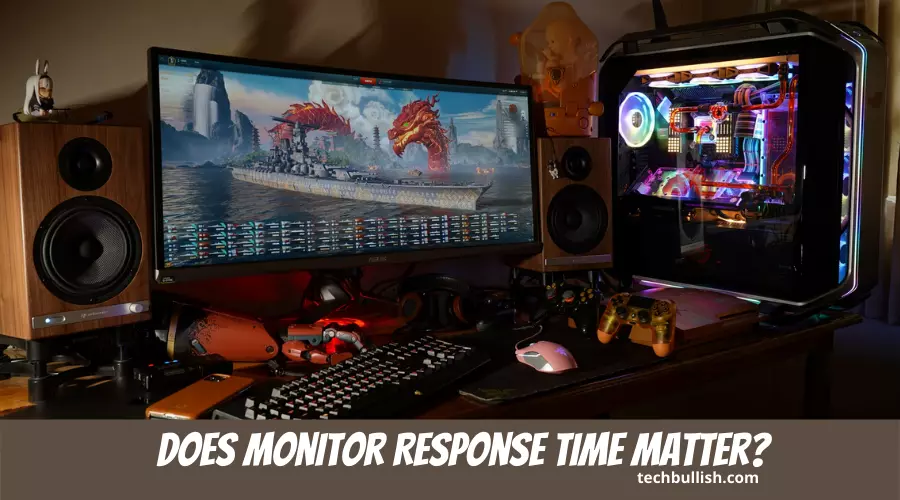When we are shopping for a new monitor, we check the size and resolution, and most of the time, it is the response time that we check last.
So, Does monitoring response time matter?
The fact is that if you are a gamer, the response time of your monitor is as important as the size and the resolution.
The lower the response time of your monitor is, the faster the monitor is.
Let’s get started!
Does Monitor Response Time Matter?
Response time matters in the monitor’s performance because it is related to how fast pixels can change color. Low response times are best where it takes less time for the monitor to change the colors on the screen when compared to higher response times that lead to ghosting or blurring on the net.

It is one of the most important factors to consider when purchasing a monitor.
What is Response Time in Monitor?
Response time (also known as “gray to gray,” “rise and fall,” or “grey to grey”) is the time it takes a pixel to go from pure black to pure white and back to black again or vice versa.
It is usually measured in milliseconds (ms), and generally, the lower, the better.
Also, smoother motions stem from short response durations.
Does Monitor Response Time Matter for Gaming?
As a casual gamer, the monitor’s response time is less of a concern. In some cases, high response times can make certain games unplayable or even frustrating.
On the one hand, the game might not respond to player input fast enough, and as a result, your character may move randomly through space.
More intense gamers with higher speeds play games that require low monitor latency standards.
Examples include when playing first-person shooters and action/strategy titles where aiming quickly down sightlines is necessary for successful hits to win the games.
How Important is Response Time on a Monitor?
Response time is vital to the user experience on a monitor, and it typically ranges from 2ms to 8ms, most being 6ms for a good gaming monitor. This is the time it takes for a monitor to change the color of a pixel to another color.
The most important thing to take away from this is that you always want a monitor with a low response time.
A high response time can ruin your experience, as you will see blurriness in your images and a lag in your mouse movements.
So make sure always to choose a quality monitor with a low response time.
Does it Matter if the Monitor Response Time is Normal or Fast?
Yes. A fast monitor with a low response time will feel slow. On the contrary, a too-fast monitor can make images difficult to read and cause eye fatigue.
Response time can make or break a device when it comes to monitors.
The response time is the amount of time it takes for the image on your screen to display once it receives input from the keyboard or mouse.
The longer the response time, the worse the monitor.
What is a Good Response Time for a Monitor for Gaming?
The key to a good response time is the lack of lag time on your monitor.
A TN monitor with a 1ms response time is an excellent option for gamers, while IPS monitors have up to 5ms response time. If it’s gaming or high performance you’re after, 1ms is ideal.
Is 1ms response time good?
1ms Response time is fast and is excellent for monitors specially made for gaming. The quality of the output it will deliver will be unmatched.
If the monitor has a good refresh rate, it will be a great experience with a 1ms Response time.
Is 10ms response time good?
A 10 ms response time is fairly good for normal casual gaming and good for competitive gaming.
However, getting a response time of 5ms would be advisable if you professionally play competitive games.
Is 5ms response time good for gaming?
A 5 ms response time monitor performs well during gaming sessions.
You won’t notice much difference between the 1ms and 5ms response time of monitors during your gameplay.
What is a bad response time for a monitor?
If you are using your monitor for purposes other than gaming, then a high response time would still be usable.
However, if you are into gaming, having a monitor with a response time of less than 10ms would be good, and any response time greater than that would not be advisable.
Above 10ms, if you go, you will experience good gaming if you are a casual gamer or do not play FPS gaming.
Conclusion
Let’s conclude the post on whether the monitor response time matters.
If you are an avid gamer or work in a graphic design company, a monitor with a lower response time will be of interest to you.
But if you work with spreadsheets and want to browse the web, response time may not be necessary to you.
So, checking the response time is a must whenever you look for a new monitor. A faster response time is generally preferred because it means the monitor will display fast-moving images without showing tearing or other artifacts.
Monitors with response times of 5ms or less are considered very good.

I’m Anirban Saha, Founder & Editor of TechBullish. With a B.Tech in Electronics and Communication Engineering, and 6+ years of experience as a software developer, I have expertise in electronics, software development, gadgets, and computer peripherals. I love sharing my knowledge through informational articles, how-to guides, and troubleshooting tips for Peripherals, Smart TVs, Streaming Solutions, and more here. Check Anirban’s Crunchbase Profile here.
